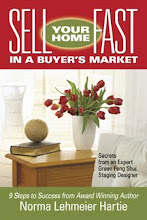If you have a lawn, keep it well maintained. Once weeds, overgrown or dead bushes, trees and other eyesores have been eliminated, you can easily and inexpensively enhance your property to draw buyers.
Annual Flowers
Nothing beats annuals for the warm months, because they bloom continuously, adding vibrant color. You can buy them in flats, cell packs of 6 or 8, or when larger, individually.
If you are not familiar with annuals, read the description and care tags that come with the plant. The majority of annuals thrive in full sunlight, which is six or more hours of sunlight per day. The easiest annuals to grow in the shade are impatiens, which come in many different colors. The directions will tell you how far to space annuals and the size they grow. If you are in a hurry to make them look good, just space them closer together.
Annuals can be planted directly in the ground, in hanging planters, and in containers. If there is space for hanging planters, like on a porch, readymade ones are handily available.
If you have removed shrubs or other plants and have empty areas in your gardens, planting annuals will quickly and inexpensively fill the space—and with the added bonus of color.
A few large planters, filled with annuals, can make a huge difference in the appearance of your property.
Landscaping
- Add fresh mulch to your garden beds. Use natural cedar mulch, as the artificially colored red and black ones are a real turnoff to many people.
- Keep edging between transitional areas like grass and gardens or grass and stone pathways, neat and crisp.
- If you are feeling creative, you can add stones or rocks around trees and shrubs. Garden centers and masonry stores carry a variety of decorative rocks. If you choose to use rocks, select ones that are local, for a natural look. I use river rocks that come in shades of grey and are dredged from local rivers. Do the next owners a favor and put landscape fabric down first, to discourage weeds.
- If you are using rocks on areas that get walked on, use ones that are two inches or less for ease of movement. Larger rocks—two to three inches—are best around shrubs and trees. To keep rocks in place and give them a finished look and to help keep them in place, you can edge them with rocks that are about six inches or larger.
- Make certain that you have adequate outdoor lighting along walkways. If you don't, consider adding solar lights, as they are less expensive than hiring an electrician to install and they are eco-friendly.
Outdoor Living Spaces
Outdoor living spaces are becoming increasingly popular. A key element is some kind of patio or deck. If you don't already have one, consider adding a patio or deck to your property.
Decks are raised off the ground and are made with either wood or wood polymer composite. The composites are a mix of wood fiber and recycled plastic. Composite boards are more expensive than natural or pressure treated wood, but they last longer and require virtually no maintenance. The environmental advantage in using composite decking is that less wood is used in production, replacement time is less than what is needed for wood decks, and the recycled materials end up in the deck, not in landfills.
A patio is built directly on the ground. Patios are made from bricks, concrete, pavers, flagstone, slate or other natural rock, or even gravel and small rocks.
Depending on your budget and the value of your home, you may wish to install an outdoor kitchen, or simply add a built in barbeque grill. Both are currently very popular. Outdoor kitchens can be elaborate, complete with refrigerator/freezer, sink, counters, electricity, stove, oven and a bar.
If you do add a patio or deck, include a few pieces of outdoor furniture to help buyers visualize themselves enjoying their outdoor refuge. If you don't own any outdoor furniture, but want pieces for your next place, now would be the time to buy. Even a couple of chairs and a table adds ambience. If you are not interested in furniture for your next home, you can buy very inexpensive chairs and a table—or use any board set on something to resemble a table. Add a colorful tablecloth or sheet and you have created a terrific space for relaxation.
.jpg)

